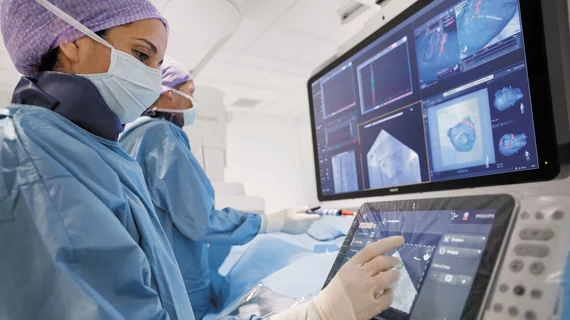A practice ‘imperative’: Schooling referrers on interventional radiology’s broad range of services
It is imperative for growing interventional radiology practices to educate referring physicians about the broad range of services offered by the subspecialty. Thankfully, academic imaging experts have come up with a solution to help spread the word.
Researchers developed a series of 60-minute lectures to share with emergency and internal medicine residents. The talks cover a range of information, including indications, imaging, pre-procedure prep, complications, and follow-up for IR procedures, according to an analysis published Tuesday.
Assessing the results afterward, investigators found statistically significant improvement in post-lecture quiz scores, with docs demonstrating a much greater knowledge about the profession and its capabilities.
“Despite the broad range of innovative and essential therapies interventional radiology offers, awareness among the medical community remains very limited,” lead author Ashley Sweeney, MD, with Ohio State University Medical Center’s Department of Radiology, and colleagues wrote June 8. “As IR tends to be a predominantly consult/referral-based service, it is imperative for growing IR practices to increase awareness of the breadth of their services amongst the referring providers.”
Sweeney and colleagues developed the lecture series with a focus on common and emerging IR procedures at a tertiary medical center. The first iteration explored central venous access, IVC filters and image-guided biopsies, while the second reviewed biliary and genitourinary interventions alongside embolization related to trauma and gastrointestinal bleeds. The talks were presented to resident physicians in emergency internal medicine as part of weekly didactic conferences.
Participants completed assessments beforehand and afterward to gauge their IR know-how. Altogether, 77 residents participated, with scores leaping from 36% to 82% on the first lecture and 44% to 65% on the second.
“It is likely that these results could be generalized from [emergency and internal medicine] resident-directed lectures to lectures directed to a wider array of residents who refer patients to IR,” the authors concluded. “Incorporation of a lecture series on common IR procedures into the resident curriculum of frequent referral specialties has potential for raised awareness of the specialty as well as improved knowledge of the common IR procedures.”
You can read more about the investigation in Current Problems in Diagnostic Radiology here.

